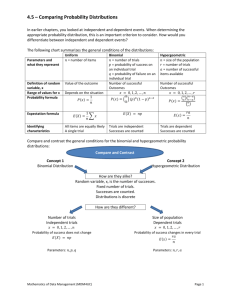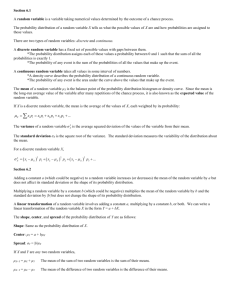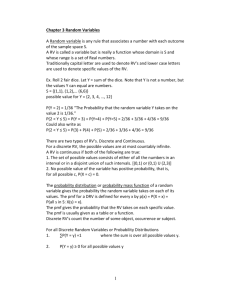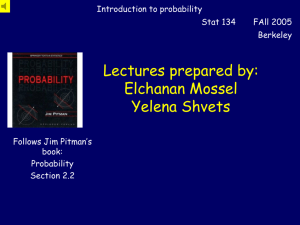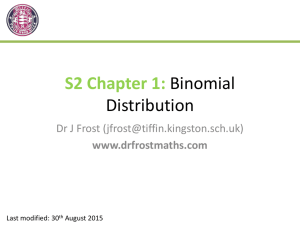rev-dept-june13-ch5-26mc
advertisement
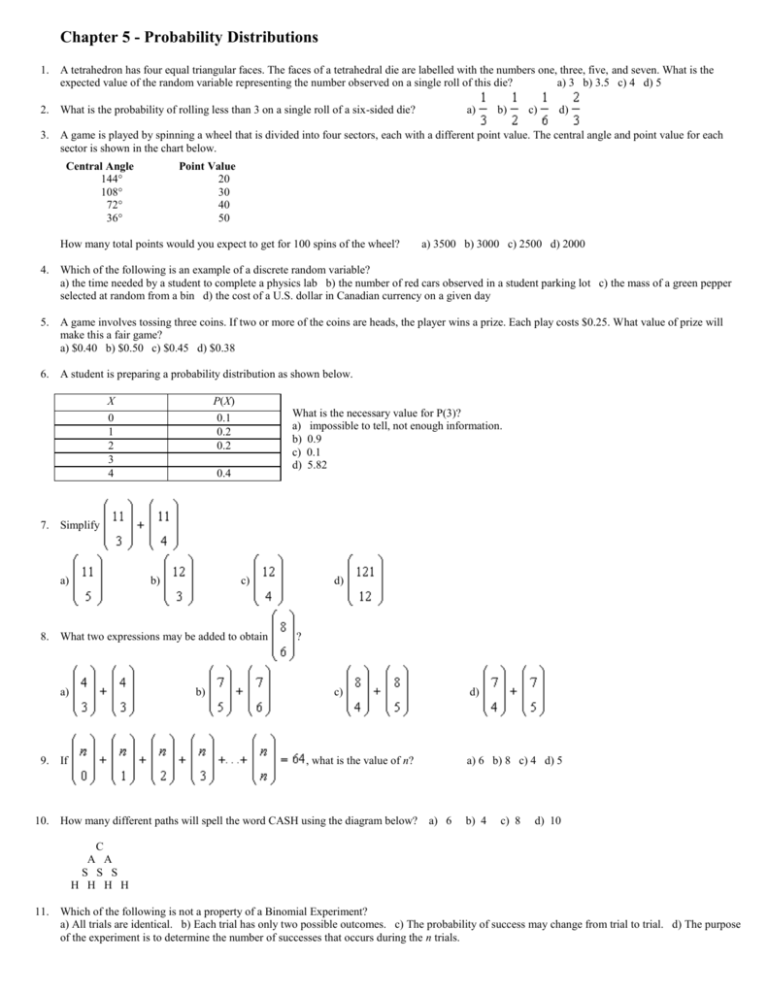
Chapter 5 - Probability Distributions 1. A tetrahedron has four equal triangular faces. The faces of a tetrahedral die are labelled with the numbers one, three, five, and seven. What is the expected value of the random variable representing the number observed on a single roll of this die? a) 3 b) 3.5 c) 4 d) 5 2. What is the probability of rolling less than 3 on a single roll of a six-sided die? a) b) c) d) 3. A game is played by spinning a wheel that is divided into four sectors, each with a different point value. The central angle and point value for each sector is shown in the chart below. Central Angle 144° 108° 72° 36° Point Value 20 30 40 50 How many total points would you expect to get for 100 spins of the wheel? a) 3500 b) 3000 c) 2500 d) 2000 4. Which of the following is an example of a discrete random variable? a) the time needed by a student to complete a physics lab b) the number of red cars observed in a student parking lot c) the mass of a green pepper selected at random from a bin d) the cost of a U.S. dollar in Canadian currency on a given day 5. A game involves tossing three coins. If two or more of the coins are heads, the player wins a prize. Each play costs $0.25. What value of prize will make this a fair game? a) $0.40 b) $0.50 c) $0.45 d) $0.38 6. A student is preparing a probability distribution as shown below. X 0 1 2 3 4 P(X) 0.1 0.2 0.2 What is the necessary value for P(3)? a) impossible to tell, not enough information. b) 0.9 c) 0.1 d) 5.82 0.4 7. Simplify a) b) c) 8. What two expressions may be added to obtain a) b) 9. If d) ? c) d) , what is the value of n? 10. How many different paths will spell the word CASH using the diagram below? a) 6 b) 8 c) 4 d) 5 a) 6 b) 4 c) 8 d) 10 C A A S S S H H H H 11. Which of the following is not a property of a Binomial Experiment? a) All trials are identical. b) Each trial has only two possible outcomes. c) The probability of success may change from trial to trial. d) The purpose of the experiment is to determine the number of successes that occurs during the n trials. 12. In the expression , which value represents the number of trials? 13. In the expression a) 2 b) 3 c) 5 d) 8 , which value represents the number of successes? a) 3 b) 10 c) 5 d) 7 14. Which expression describes the probability of k “3s” being rolled on 20 successive rolls of a six-sided die? a) b) c) d) 15. A baseball player hits the ball to left field 20% of the time, to centre field 35% of the time, and to right field 45% of the time. Which of the following expressions gives the probability distribution for the number of hits to centre field for a game in which the batter gets 5 hits? a) b) c) d) 16. The probability of a computer memory chip being defective is 0.02. Which of the following statements is true? a) In a shipment of 100 chips, two will be defective. b) The expected number of defective chips in a shipment of 500 is ten. c) In a shipment of 1000 chips, it is certain that at least one will be defective. d) All statements above are false. 17. Which statement regarding the probability distribution for a binomial experiment with p = 0.5 is not true? a) The probability of no successes must equal the probability of no failures. b) The graph of the distribution is symmetrical. c) The expected value of the experiment is half the number of trials. d) The more trials that are made, the higher the probability that all trials will be successful. 18. A student suggests the following expression to represent the probability of achieving four successes in seven trials of a binomial experiment for which the probability of success is 0.3. What error did the student make? a) The second exponent should be a 7. b) The probabilities for success and failure were reversed from their proper positions. c) The probability of failure should be 0.7. d) The first exponent should be a 7. 19. For which of the following binomial experiments could the normal approximation not be applied? a) n = 10 and p = 0.5 b) n = 20 and p = 0.2 c) n = 100 and p = 0.4 d) n = 20 and p = 0.3 20. What is the value of a) x for the normal approximation to a binomial experiment with 50 trials and a 40% likelihood of success for any given trial? b) 22.5 c) 20 d) 25 21. The z-score for a particular value of X is 0.18. What is the total probability of this or any smaller value of X occurring? a) 42.9% b) 57.1% c) 96.4% d) 3.6% 22. The normal approximations to two binomial experiments are compared. Both have 20 trials, but the first has p = 0.4 and the second has p = 0.7. Which statement is not true? a) Both binomial distributions may be approximated by a suitable normal distribution. b) The first distribution is more symmetrical than the second. c) The highest point for the first distribution is found above X = 8. d) The normal approximation is a closer fit to the actual binomial distribution for the second experiment than for the first. 23. Which of the following binomial experiments has the normal approximation with the smallest standard deviation? a) n = 50 and p = 0.45 b) n = 20 and p = 0.45 c) n = 40 and p = 0.55 d) n = 10 and p = 0.55 24. What is the value of the standard deviation for the normal approximation to a binomial distribution with 600 trials and a probability of success of 0.6? a) 12 b) c) 6 d) 0.24 25. A novice competitor in biathlon hits 80% of her targets. What is the probability that she will hit more than 45 of 50 targets attempted? a) 19.4% b) 80.6% c) 2.6% d) 97.4% 26. An antibiotic is effective against a particular strain of streptococcus 70% of the time. What is the probability that at least 70 of 100 cases will respond when treated with this antibiotic? a) 54.4% b) 45.6% c) 70% d) 49% Chapter 5 Answers 1 C 2 A 3 B 4 B 5 B 6 C 7 C 8 B 9 A 10 C 11 C 12 D 13 A 14 A 15 C 16 B 17 D 18 C 19 B 20 C 21 B 22 D 23 D 24 A 25 C 26 A






